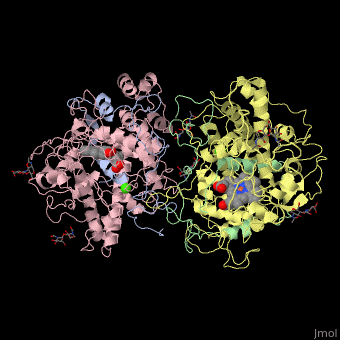1myp
From Proteopedia
X-RAY CRYSTAL STRUCTURE OF CANINE MYELOPEROXIDASE AT 3 ANGSTROMS RESOLUTION
Structural highlights
DiseasePERM_HUMAN Defects in MPO are the cause of myeloperoxidase deficiency (MPOD) [MIM:254600. A disorder characterized by decreased myeloperoxidase activity in neutrophils and monocytes that results in disseminated candidiasis.[1] [2] [3] [4] [5] FunctionPERM_HUMAN Part of the host defense system of polymorphonuclear leukocytes. It is responsible for microbicidal activity against a wide range of organisms. In the stimulated PMN, MPO catalyzes the production of hypohalous acids, primarily hypochlorous acid in physiologic situations, and other toxic intermediates that greatly enhance PMN microbicidal activity. Evolutionary ConservationCheck, as determined by ConSurfDB. You may read the explanation of the method and the full data available from ConSurf. Publication Abstract from PubMedThe three-dimensional structure of the enzyme myeloperoxidase has been determined by X-ray crystallography to 3 A resolution. Two heavy atom derivatives were used to phase an initial multiple isomorphous replacement map that was subsequently improved by solvent flattening and non-crystallographic symmetry averaging. Crystallographic refinement gave a final model with an R-factor of 0.257. The root-mean-square deviations from ideality for bond lengths and angles were 0.011 A and 3.8 degrees. Two, apparently identical, halves of the molecule are related by local dyad and covalently linked by a single disulfide bridge. Each half-molecule consists of two polypeptide chains of 108 and 466 amino acid residues, a heme prosthetic group, a bound calcium ion and at least three sites of asparagine-linked glycosylation. There are six additional intra-chain disulfide bonds, five in the large polypeptide and one in the small. A central core region that includes the heme binding site is composed of five alpha-helices. Regions of the larger polypeptide surrounding this core are organized into locally folded domains in which the secondary structure is predominantly alpha-helical with very little organized beta-sheet. A proximal ligand to the heme iron atom has been identified as histidine 336, which is in turn hydrogen-bonded to asparagine 421. On the distal side of the heme, histidine 95 and arginine 239 are likely to participate directly in the catalytic mechanism, in a manner analogous to the distal histidine and arginine of the non-homologous enzyme cytochrome c peroxidase. The site of the covalent linkage to the heme has been tentatively identified as glutamate 242, although the chemical nature of the link remains uncertain. The calcium binding site has been located in a loop comprising residues 168 to 174 together with aspartate 96. Myeloperoxidase is a member of a family of homologous mammalian peroxidases that includes thyroid peroxidase, eosinophil peroxidase and lactoperoxidase. The heme environment, defined by our model for myeloperoxidase, appears to be highly conserved in these four mammalian peroxidases. Furthermore, the conservation of all 12 cysteine residues involved in the six intra-chain disulfide bonds and the calcium binding loop suggests that the three-dimensional structures of members of this gene family are likely to be quite similar. X-ray crystal structure of canine myeloperoxidase at 3 A resolution.,Zeng J, Fenna RE J Mol Biol. 1992 Jul 5;226(1):185-207. PMID:1320128[6] From MEDLINE®/PubMed®, a database of the U.S. National Library of Medicine. Loading citation details.. Citations No citations found See AlsoReferences
|
| |||||||||||||||||||


